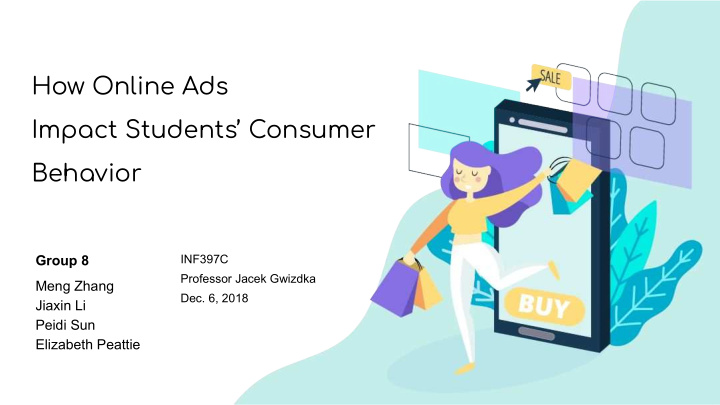



How Online Ads Impact Students’ Consumer Behavior Group 8 INF397C Professor Jacek Gwizdka Meng Zhang Dec. 6, 2018 Jiaxin Li Peidi Sun Elizabeth Peattie
Agenda Introduction and Research Questions ● Population, Sampling, Recruitment and Response ● Data Analysis ● Descriptive Statistics ○ Inferential Statistics ○ Limitations ● Q&A ●
Introduction Purpose: Why online advertising? ● Our heavy internet usage ○ Multiple sources and formats of advertisements ○ Effectiveness of current strategies ○ Population: Undergraduate and graduate students ● Sample: UT Austin undergraduate and graduate students ● Recruitment: Qualtrics survey emailed to teams’ UT student networks and acquaintances, as ● well as social media apps Response: 42 responses ●
Demographics of Respondents
Research Questions What are the students’ preferences for online advertisements? ● What are the students’ attitudes towards personalized ads? ● Do students have different reactions after being exposed to online ads, particularly certain ● groups of students? How do students judge their purchases after exposure to online ads? ●
Descriptive Statistics Q: “Rank the sources of online ads they frequently meet (1 stands for most frequently).” Insights: Mean and variance of the rank results.
Descriptive Statistics Q: “Rank their trust on online ads from different sources.” Insights: Percentage of students who have most trust in online ads from a certain source.
Descriptive Statistics Q: “Chose three contents of online ads which are most helpful in their decision to purchase.” Insights: Detailed product information and user review are most helpful information for students rather than well-designed slogan or colorful poster.
Descriptive Statistics Q: “Would you like to see more customized online ads?” Insights: The ratio of students who would like to see more customized online ads in the future to those who wouldn’t is near 3:2.
Descriptive Statistics Q: “How likely are you to eventually buy something after repeatedly seeing the same item?” Insights: most students’ attitudes toward customized online ads are vacillating, and it could depend on the specific items advertised or the situations in which they view them.
Inferential Statistics Q: “Do students have different reactions after being exposed to online ads, particularly certain groups of students?” Methods: Independent Sample T test & Spearman’s rho correlation Demographic Features: Attitudes: Gender: Male & Female ● Helpfulness ● Relevance Age: Under 21 ● Reliable 21-25 26-30 Impulsive Purchase Behaviors 31-35 36 and up
Inferential Statistics Analysis Result - Gender Null hypothesis: there is no significant difference in attitudes of male and female for online advertisements. Refused! Null hypothesis: there is no significant difference in impulsive purchase behaviors between male and female. Accepted!
Inferential Statistics Analysis Result - Age Spearman’s rho Correlation There is no significant correlation between age and other factors.
Limitations ● Sample : 42 students, cover 16 male students (38%) and 25 female students (60%) ● Questions : some questions and choices cannot collect effective results ● Open-ended question : not enough complete answers ● Rank question : some students only kept the original order pattern
Q&A
Recommend
More recommend